Between 2011 and 2012, now-Governor Greg Abbott demolished a 4,500-square-foot home in West Austin to build himself an even bigger house, complete with an inground pool. Since 2015, he’s had even sweeter digs: the stately gubernatorial mansion across from the Texas Capitol. By contrast, Abby, John, “Black,” Jolie, Gilbert, and “Uncle Ray” live nestled beneath Austin’s highway overpasses. At night, they curl up in tents—when they’re lucky—to fend off the elements.
In recent months, the governor has taken to Twitter to spin a narrative of violence and filth about Austin’s homeless population. Beginning Monday, he plans to use state police and the transportation department to clear out homeless camps beneath the capital city’s highways. For the past two weeks, I’ve been meeting with the folks who call those camps home to learn why they live there.
Take Abby and John, a married couple originally from the Houston-area who’ve lived homeless in Austin for five years and asked I not use their real names. Like most homeless on the city’s streets, they won’t go to the Austin Resource Center for the Homeless, the city’s major downtown shelter: They consider the area drug-filled and dangerous, plus they’d have to separate by gender. They’re desperate for a real home, but financial housing assistance in Austin takes years to come through for most applicants. For a time, they lived in a wooded area in North Austin, until one winter day they both wound up sick in the hospital, and when they returned, their tent and possessions had vanished. They then bounced around, sleeping in stairwells or wherever made sense each night, moving along whenever police told them to.
Then, in June, Austin gave them a new option: The city council lifted a 25-year-old city-wide ban on camping in public places. Thanks to the new rules, Abby and John could set up a gray tent under I-35 near downtown without fear of being ticketed or arrested. It’s far from perfect: They say passersby sometimes yell at them, honk their horns, or throw bottles, and some of their neighbors have drug and alcohol issues. But having something resembling four walls around them means a lot.
“Black” and Jolie are another couple living under I-35. Black, who’s been homeless three years in Austin, says he was already living in a tent before the camping policy changed, but police would periodically order him to take it down or move it. He says he accumulated 12 tickets for violating the city’s camping ban, which became warrants when he no-showed for court. “It was stupid. I didn’t have no money [to pay the fines]; I was barely eating,” he said. “But since they passed that new law, they haven’t been fucking with us.”
Jolie, who’s from San Antonio and is just 21 years old, said she should get housing soon through a nonprofit that works with homeless youth. But now, she’s afraid the governor will take away her current best option. “If they kick us out of here, I’d head to the next bridge, or if I can’t do that, then I don’t know,” she said. “It’s crazy how they’re doing this, because we don’t have nowhere to go.”
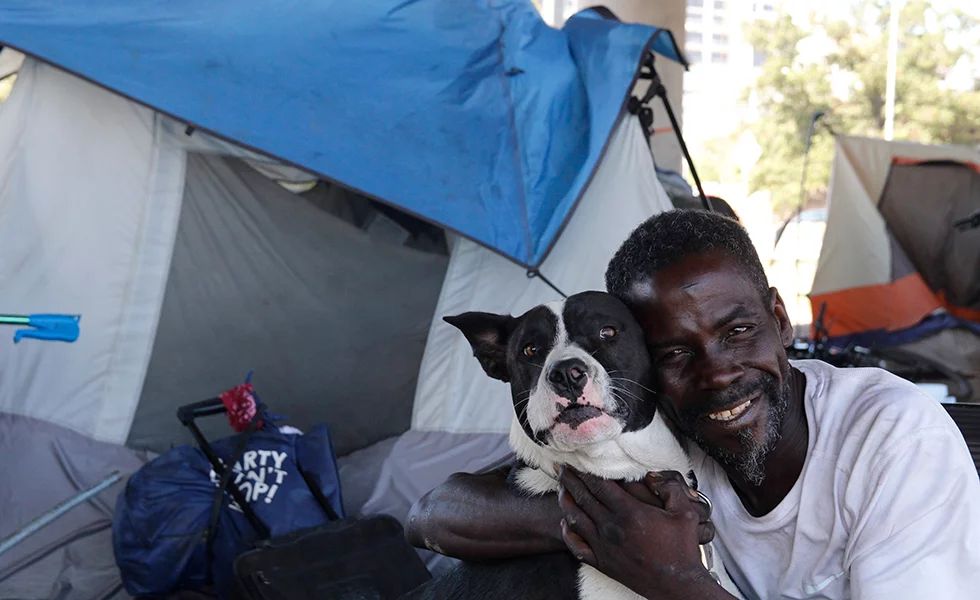
"Black" poses with his dog, Mr. Prince, at a camp near downtown Austin, Gus Bova
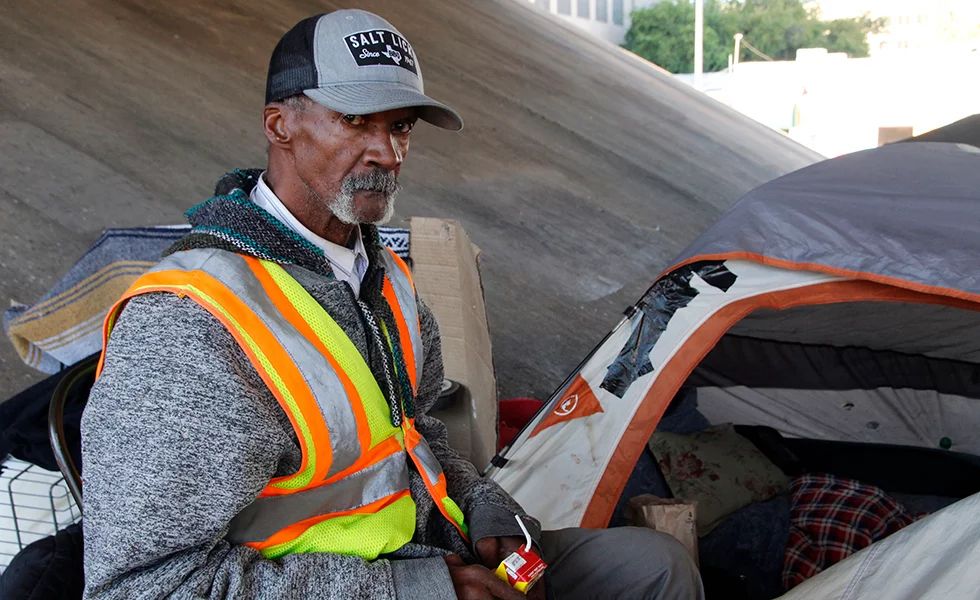
Erroll Crawford says he's a Vietnam veteran originally from New Orleans, who was first made homeless by Hurricane Katrina. Gus Bova
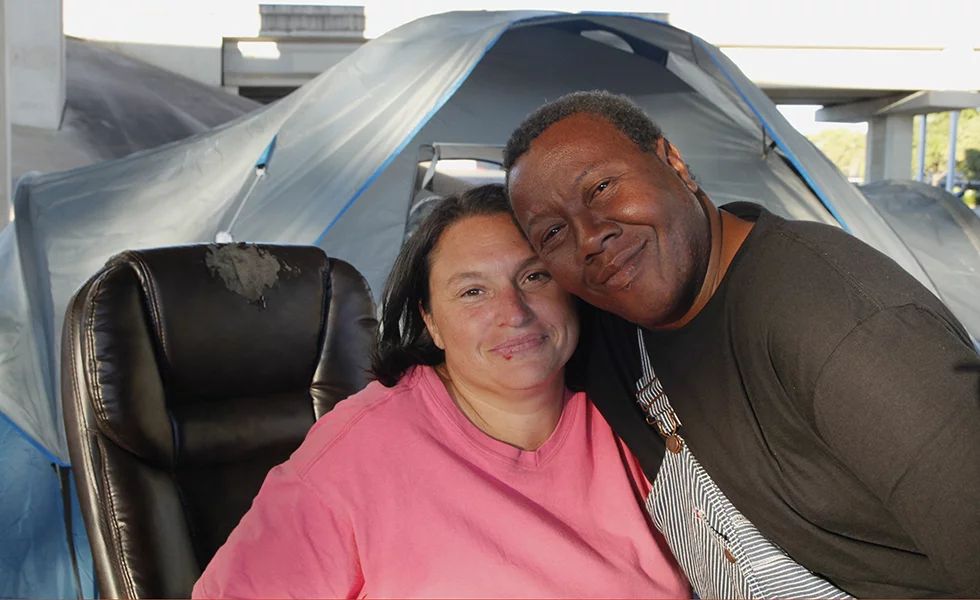
Gilbert and Crystal, a couple living at a camp in South Austin. Gus Bova
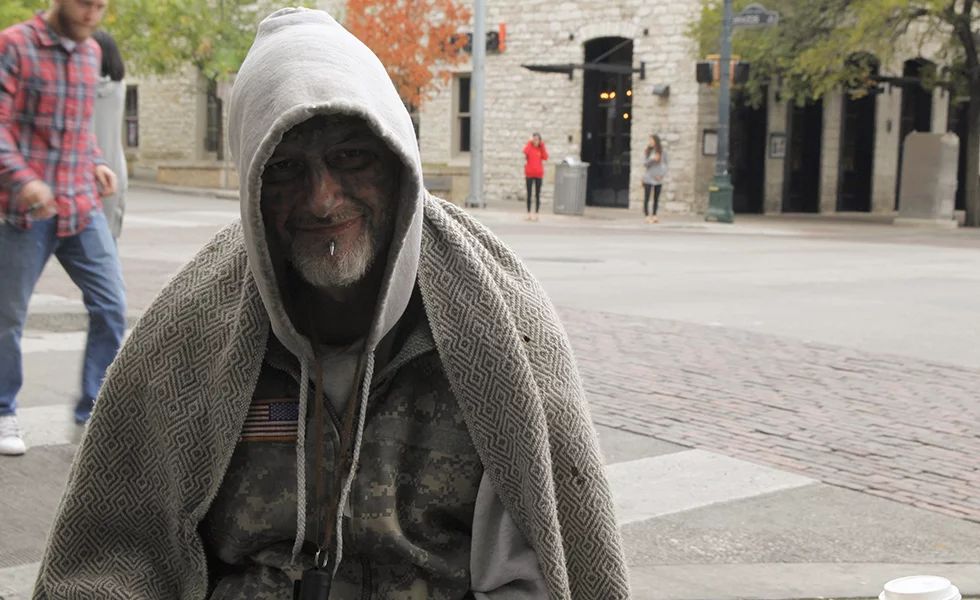
Mark, pictured in downtown Austin, says he's a Gulf War veteran. He's also a drummer. Gus Bova
The political firestorm over Austin’s homelessness policies ignited right after the late-June meeting when city council partially repealed three ordinances criminalizing the actions of sitting, lying, camping, or begging in public. In response, some homeless folks emerged from wooded areas to stay in places like highway underpasses. Those already under the highways erected more tents, increasing the visibility of homelessness in the city—though, according to service providers, not changing the actual number of homeless.
Some saw Austin’s move as a sudden attack on decency and public order. But the decision was years in the making. In 2017, an Austin city audit found the ordinances “may create barriers for people as they attempt to exit homelessness” by burdening them with a criminal record. The audit also noted that Austin’s panhandling ban was likely illegal: Thanks to a 2015 Supreme Court ruling regarding freedom of speech, courts have been swatting down such policies nationwide on First Amendment grounds. In fact, even before June, Austin police had already scaled back ticketing dramatically for all three ordinances: Citations dropped from more than 9,000 in 2014 to under 1,000 in 2018. (Though police could still use the threat of tickets to achieve “voluntary compliance,” as the cop-speak goes).
Austin’s decision was also part of a nationwide campaign to decriminalize homelessness. In 2016, a pair of national nonprofits launched the “Housing not Handcuffs” campaign to drive awareness of criminalization policies like Austin’s. Last September, the movement got a boost when the Ninth Circuit Court of Appeals ruled it unconstitutional to punish people for camping outside when shelter beds aren’t available. Since then, a number of West Coast municipalities have stopped enforcing or repealed their camping bans. But Austin, as the governor would have you remember, is not on the West Coast. As usual when Texas’ capital pushes the bounds of how progressive a Southern city can be, our otherwise laissez-faire state has laced up the jackboots.
Since June, the governor has issued a stream of tweets about Austin’s supposed crisis of the homeless-gone-wild. He shared a tweet claiming that homeless individuals caused a car crash downtown, a story that later proved false; he promoted a video of a man throwing a metal sign at a vehicle, even though the incident was nearly two years old and the man turned out not to be homeless at all; he also cherry-picked crimes, which APD had already handled, to further a narrative of lawlessness. Many of the claims he’s promoted were first spread by Republican Party operatives or by pseudonymous accounts dedicated to bashing Austin’s homeless. As critics note, the governor has regularly drawn Texans’ attention to acts, like assault and theft, that were just as criminal before June as they are now.
“He’s not tweeting pictures of a woman sleeping with her child or a person sitting on the sidewalk peacefully asking for money,” said city council member Greg Casar, who helped lead the decriminalization effort. “So it’s just totally political; he’s just trying to score political points by punching down at the poorest people in our community.”
Abbott did not respond to requests for comment for this story. Travis County GOP Chair Matt Mackowiak, who launched a Change.org petition opposing the council’s changes and hopes to get a measure on next May’s ballot to reinstate the old camping ban, told me that his efforts are not a partisan attempt to whip up Republican votes. He directed me to a Medium post he wrote where he argues “city leaders are fiddling while Austin burns.” But a quote he gave to the Washington Post in August is telling: “This is our best example of overreach, so we have been very strategic focusing on this issue,” he said. A PAC has also been formed with the intent to recall most of city council over the ordinance changes.
In October, APD released crime stats showing that, if anything, the most notable impact following the ordinance changes was a 42-percent jump in property crimes by the non-homeless against the homeless. (That difference may or may not have anything to do with the ordinance changes.) Austin’s police chief has also denied there is a “public safety” crisis, but Abbott has continued to paint Austin as suddenly riddled with assaults by the unhoused. In the same vein, Abbott has said Austin is now piling up with “feces” and “needles,” even as city public health officials insist there’s no evidence these problems are worse than they were before June. (For what it’s worth, in my time in the camps, I saw some feces, no needles.)
Homeless advocates say Abbott, along with President Donald Trump, is using the homeless issue as a political wedge and, in so doing, is inflaming a different crisis: The National Coalition for the Homeless has documented nearly 2,000 possible hate crimes against the homeless since 1999. “My real fear is the lasting damage that Trump and the governor are doing is dehumanization of the homeless population that will lead to more vigilante incidents,” said Eric Tars, with the National Law Center on Homeless and Poverty. In July in Austin, someone reportedly threw a lit firecracker at a homeless couple’s tent, ruining it.
Meanwhile, direct service providers find the governor’s comments unhelpful at best. “He’s adding more fuel to the controversy around the ordinances,” said Greg McCormack, director of Austin’s Front Steps nonprofit, which runs the downtown ARCH shelter. “I don’t think it’s helped with finding solutions for homelessness.”
In early October, Abbott escalated his feud with Austin city leaders. The governor sent Austin Mayor Steve Adler a letter threatening to deploy a host of state agencies to combat Austins’ homeless, including threats to use state police to arrest for trespassing violations and the state health department to impose “quarantines.” On October 17, Austin’s city council revisited its camping ordinance and re-imposed restrictions on sidewalks and within a certain radius of homeless shelters. Since then, Abbott seems to have narrowed his threats, focusing on a state cleanup of the camps under highway overpasses.
Starting Monday morning, according to state and local officials, the Texas Department of Transportation (TxDOT) will send cleaning contractors accompanied by state police to homeless encampments near downtown and along highways in North and South Austin. The exact scope of the action remains unclear: A TxDOT spokesperson, Diann Hodges, told me that any items left behind will be removed and personal belongings, including tents and bags, will be stored at an off-site location for 30 days for owners to pick them up. A state police spokesperson told me that criminal trespassing charges could be levied at TxDOT’s behest against anyone who refuses to leave, but Hodges said that won’t happen because “they are not trespassing.” It’s unclear what might happen to anyone who leaves and returns to camp in the same location: Abbott has instructed TxDOT to clean once a week or more, reports KVUE.
Chris Baker, director of The Other Ones Foundation, a nonprofit that helps Austin’s homeless get work, told me his organization was asked by a state contractor to help with the cleanups, but he decided to pull out this week over concerns the state would be “too heavy-handed.”
TxDOT has posted notices at campsites that list three local homeless shelters to contact, but those shelters are full and have long waiting lists. McCormack, the Front Steps director, told me that Abbott’s office only contacted him the evening before the operation was announced, and that was the first time the governor had reached out about Austin’s homelessness problem. In general, “sweeps” of homeless encampments are discouraged by service providers and the federal Interagency Council on Homelessness, which wrote in 2015 that “forced dispersal of people from encampment settings … accomplishes nothing toward the goal of linking people to permanent housing opportunities, and can make it more difficult to provide such lasting solutions.”
This controversy comes as Austin, over the last couple of years, has put unprecedented resources toward ending homelessness in the city. The 2019-2020 city budget includes nearly $63 million to address the issue, a $17 million jump over the previous year, and the city passed a $250 million affordable housing bond last year. In June, on the same day the criminalization ordinances were changed, the city approved an $8.6 million shelter in South Austin. The city has also swiftly slashed the population of homeless veterans and youth, and at a recent council meeting, it was reported that more than 400 homeless “households” had been housed in the last three months.
At the same meeting, Adler suggested the state could help out by funding more services for those exiting the prison system, the foster system, and for mental health services. According to Eric Samuels, president of the Texas Homeless Network, Texas does allocate some $11.4 million to addressing homeless in the sprawling Lone Star State. But “it’s far less than needed,” he said, noting that Ohio—with less than half the population—pitches in $3 million more.
It’s reasonable to question whether Austin should have done more faster to address its homeless population, and it’s also fair to ask whether the city should have built more shelters before changing its ordinances. Some advocates say just that. “I’m for the decriminalization of homelessness, but I do think the city should have done a better job in preparing shelter spaces … and communicating with the public,” Samuels said. But it’s baseless, as some conservatives have claimed, to say the city isn’t taking homelessness seriously.
Homelessness is tough to solve. In part, that’s for the reasons you often hear about: A sizable minority of the homeless population suffers from serious mental illness and addiction. But the problem, advocates say, is also systemic: There’s simply a persistent gap between people’s incomes and the cost of housing. Nationwide, the minimum wage hasn’t changed in 10 years, and nearly all new apartment construction in recent years has been of high-end units, with Texas’ big cities leading that charge. Texas preempts cities from setting their own minimum wages and lets state legislators essentially nix affordable housing in their districts. The affordable housing crisis is worse on the West Coast, but Austin is well on its way: Rents have increased some 17 percent since 2014.
Everyone I talked to in the city’s homeless camps complained about the soaring cost of housing in Austin. Gilbert, a 51-year-old African-American and East Austin native I met under Highway 71, connected local homelessness to gentrification. “They’re driving all the poor to the country, from the houses that our grandparents owned,” he said, noting that he has a brother and a cousin living in the same homeless encampment as him. In all, while black people compose about 8 percent of Travis County’s population, they account for 34 percent of the county’s homeless.
One predictor of homelessness is having been to prison: One 2018 study found the formerly incarcerated were 10 times more likely to become homeless—so it’s no surprise that those disproportionately targeted by the criminal justice system would wind up on the streets at similar rates. At a camp near downtown, I met Raymond Thompson, or “Uncle Ray,” a 47-year-old black man from Bastrop who said he’d served 11 years in prison, which has made it hard to get stable housing and jobs. “You never really get out [of prison],” he said. “Once you’re out, you already got the shit end of the stick. We’ve been knowing this; we can’t cry about it.”
It’s also hard to even establish the scope of homelessness. The federally mandated “point-in-time” count, or PIT count, is the most accessible enumeration of America’s homeless. By that count, Texas has about 25,000 homeless on a given night and Austin has a little over 2,000—both numbers that have been fairly stable for a few years but are substantially down from about a decade ago. But the PIT count is widely considered an underestimate: Homeless folks are regularly missed by volunteer counters, and those in hospitals and jail on the night of the count are overlooked. That’s not to mention that different federal departments and nonprofits define “homeless” differently. Many advocates still use the PIT count to identify trends, but the National Law Center on Homelessness and Poverty warns that because methodologies vary over time and between cities, even that can mislead.
The governor has made clear he’s not happy with Austin’s approach to homelessness, but his proposed solutions are murky. In an October tweet, he claimed that Dallas—which has more unhoused people than Austin—has a homeless-free downtown, a claim the local alt-weekly swiftly debunked. In another Twitter missive, he said Austin should emulate San Antonio’s 1,700-person Haven for Hope mega-shelter—even though advocates nationwide, and Alamo City officials themselves, are pivoting away from large shelters toward a “housing first” model that aims to move people swiftly into permanent, affordable housing. On Tuesday, when the governor announced his TxDOT cleanups, his spokesperson added that the Austin Chamber of Commerce would “spearhead” a coalition looking for “longer-term solutions.” A chamber spokesperson told me Wednesday that details would be forthcoming.
No one thinks camps under highways are a permanent solution. But in the short-term, they’re preferable to the homeless being scattered in deep woods and drainage ditches. McCormack, the Front Steps director, said it’s easier for caseworkers to find and follow up with people when they’re in a stable camp. And everyone I spoke to said the camps served as communities, where someone could mind your things while you went to an appointment or to scrounge some food. As Tars put it: “Organized homelessness is much better than unorganized homelessness.”
Since May, the City of Austin has cleaned the areas once a month, and is set to increase frequency in November at some sites. The city generally does not remove tents or personal belongings. Austin is also expanding trash services that help the homeless keep their own spaces clean. Both Adler and Casar told me they’re open to providing portable toilets, too, something many of the camp residents told me they could use. (Three free solar-powered restrooms are already set to pop up downtown early next year).
After months of vitriolic back-and-forth, it’s easy to forget the basic insight behind Austin’s ordinance rewrites: shuffling the homeless around, or hiding them, doesn’t end homelessness. As Abby, one of the folks camped out near downtown, told me: “They kick me out of here, I’ll downsize to my backpack again, wander around, and sleep wherever until they come and tell me to move again.”
Or, as is often the case, we could look back to Molly Ivins, the famed Texas columnist and Observer alumna. “You cannot solve homelessness by getting people out of sight or by just sweeping them off the streets,” she said way back in 1996, when Austin first passed its camping ban. Meanwhile, she pitched a sleeping bag along Congress Avenue in protest.
Read more from the Observer:
-
The Ghosts of Jefferson: This East Texas tourist town calls itself “the most haunted town in Texas,” but its whitewashed ghost stories elide a complex racial history.
-
Short Story Contest Winner: ‘Dear Mr. Gottlieb’: Alan Sincic’s story is a searing indictment of corporate America.
-
‘Ghosts of Sugar Land’ Tracks a Texan’s Path to ISIS: In this contemplative, vulnerable new documentary, a group of friends try to understand why their former classmate embraced radical Islam.
Gus Bova reports on immigration, the U.S.-Mexico border and grassroots movements for the Observer. He formerly worked at a shelter for asylum-seekers and refugees. You can contact him at bova@texasobserver.org.
Do you think free access to journalism like this is important? The Texas Observer is known for its fiercely independent, uncompromising work—which we are pleased to provide to the public at no charge in this space. That means we rely on the generosity of our readers who believe that this work is important. You can chip in for as little as .99 cents a month. If you believe in this mission, we need your help.

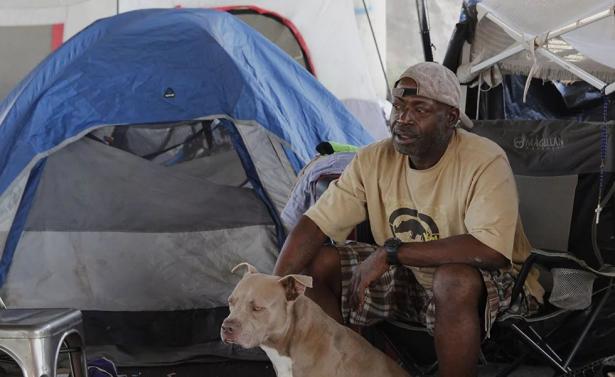
Spread the word